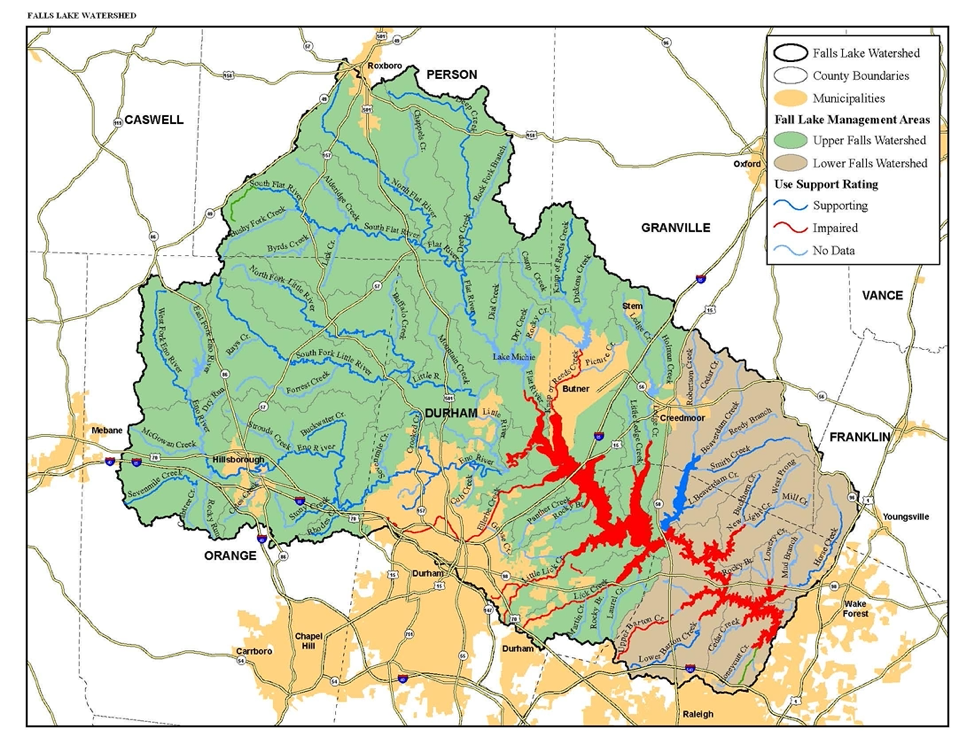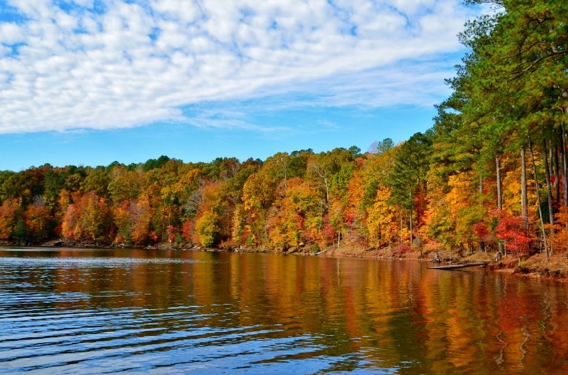By Mandy Pitz
Mandy Pitz is a senior at UNC-Chapel Hill majoring in Environmental Sciences, Quantitative Energy Systems Track.
As an environmental policy intern working with the NC Policy Collaboratory during the 2020 fall semester, I spent several months learning about the work being done by university researchers about the Falls Lake watershed.
Much of my semester was spent working with Collaboratory staff members to incorporate these research projects into an interim update, which was submitted to the General Assembly in December of 2020. I participated in stakeholder meetings and learned about the value of Falls Lake as a drinking water resource for the City of Raleigh and other municipalities.
Falls Lake Background
Falls Lake spans over 12,000 acres across Durham, Wake, and Granville counties, and is an essential resource to residents in the surrounding areas. The lake controls damaging floods, serves as a water supply source for half a million people, and protects downstream water quality during droughts. Falls Lake is also a recreational area that offers camping, boating, swimming, and hiking.
Just two years after construction was finished in 1983, the lake was classified as impaired by nutrient pollution because it exceeded state standards of chlorophyll A in reservoirs. Chlorophyll A, a photosynthetic pigment, indicates excessive algae and an imbalance of nutrients. Since that classification, stakeholders have been working to find solutions.
 Map of Falls Lake Watershed courtesy of N.C. Department of Environmental Quality
Map of Falls Lake Watershed courtesy of N.C. Department of Environmental Quality
The Falls Lake Nutrient Management Strategy was implemented in 2011 in an effort to combat nutrient pollution and improve water quality. The Strategy was developed by the North Carolina Division of Water Quality and focuses first on the lower, less-polluted portion of the lake, and secondarily on the upper basin. It targets nutrient discharge from stormwater runoff, wastewater treatment plants, agriculture, and other sources.
Following adoption of the Falls Lake Management Strategy, many local governments in the Falls Lake watershed, working through the Upper Neuse River Basin Association, have been collecting data and conducting studies to better understand the options for improving water quality in the lake.
UNC Falls Lake Study
In 2016, the North Carolina General Assembly approved a budget for the study and analysis of nutrient management strategies in Jordan and Falls Lakes. Jordan Lake was the focus for the first three years. A final report on Jordan Lake was submitted to the legislature in December 2019.
In 2020, researchers from UNC, East Carolina University, and NC State University turned their attention to Falls Lake. Mike Piehler, Director of the UNC Institute for the Environment, is the faculty lead for the entire study and has been coordinating with researchers working on a number of projects, including:
- Evaluating reservoir vulnerability to eutrophication
- Identifying sources of nutrients and sediments to Falls Lake
- Assessing likelihood of nutrient mitigation through regulatory measures and restoration efforts
- Analyzing innovative financing mechanisms and the costs and benefits of water quality improvement
As part of the Falls Lake Study, the Collaboratory submits annual interim updates to the legislature to report on the progress of the study. In my role as an intern, I was able to contribute to the development of the report and drafted several of its sections.
 Falls Lake. Source: https://sites.google.com/site/hikingnc
Falls Lake. Source: https://sites.google.com/site/hikingnc
The report includes abbreviated studies spanning interdisciplinary subjects related to the nutrient management plan. Marine scientists from UNC studied how nutrient levels changed during differing flow conditions and time scales. NCSU and the NC Department of Environmental Quality analyzed the presence and dynamics of cyanotoxins in Falls Lake, surveying lake water to measure dissolved toxin levels. East Carolina University scholars estimated the influence of onsite wastewater treatment systems and nutrient loading, and UNC’s Environmental Finance Center analyzed funding options and policy considerations.
These along with several other projects were included in the interim report that will be presented to policy makers and used to inform decisions about management practices, regulations, and funding resources. The multidisciplinary background of the researchers helped create a thorough report that will effectively inform legislators about the nutrient management of the lake.
By analyzing Falls Lake through several different lenses and fields, the Collaboratory will be able to make well-researched recommendations to the General Assembly about next steps for the Nutrient Management Strategy. The research will continue through 2022 and culminate with a final report to the General Assembly in 2023.
To learn more about the UNC Nutrient Management Study of Falls and Jordan Lake please visit: https://nutrients.web.unc.edu/


